Ziyue Jiang
UniVoice: Unifying Autoregressive ASR and Flow-Matching based TTS with Large Language Models
Oct 06, 2025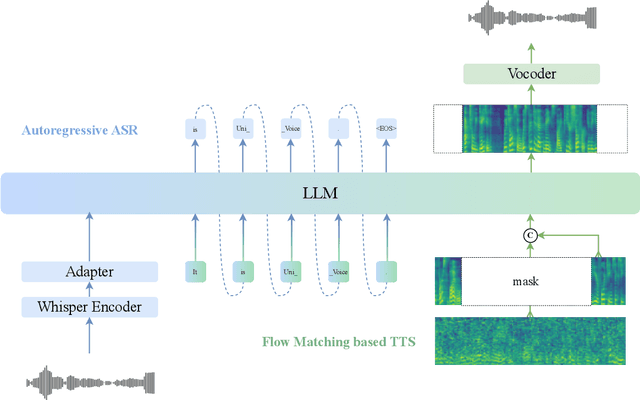
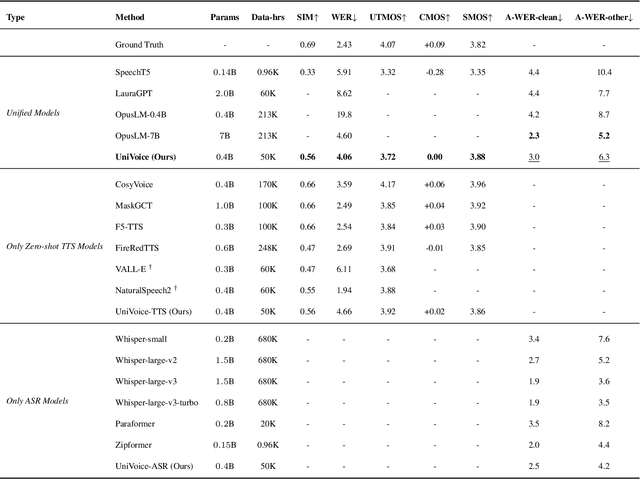
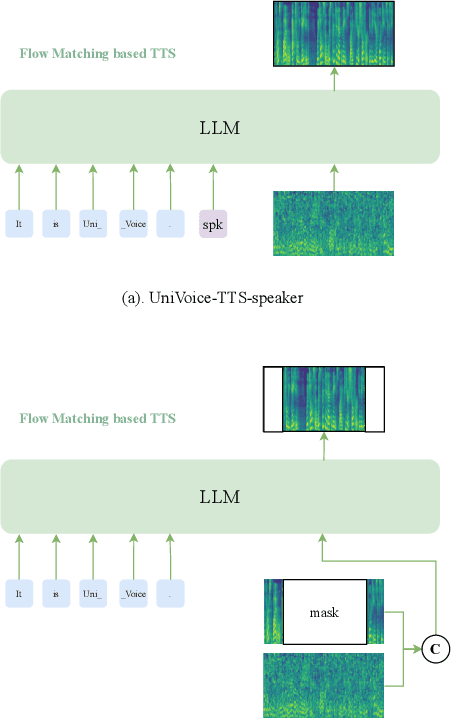

Abstract:Large language models (LLMs) have demonstrated promising performance in both automatic speech recognition (ASR) and text-to-speech (TTS) systems, gradually becoming the mainstream approach. However, most current approaches address these tasks separately rather than through a unified framework. This work aims to integrate these two tasks into one unified model. Although discrete speech tokenization enables joint modeling, its inherent information loss limits performance in both recognition and generation. In this work, we present UniVoice, a unified LLM framework through continuous representations that seamlessly integrates speech recognition and synthesis within a single model. Our approach combines the strengths of autoregressive modeling for speech recognition with flow matching for high-quality generation. To mitigate the inherent divergence between autoregressive and flow-matching models, we further design a dual attention mechanism, which switches between a causal mask for recognition and a bidirectional attention mask for synthesis. Furthermore, the proposed text-prefix-conditioned speech infilling method enables high-fidelity zero-shot voice cloning. Experimental results demonstrate that our method can achieve or exceed current single-task modeling methods in both ASR and zero-shot TTS tasks. This work explores new possibilities for end-to-end speech understanding and generation.
Discl-VC: Disentangled Discrete Tokens and In-Context Learning for Controllable Zero-Shot Voice Conversion
May 30, 2025Abstract:Currently, zero-shot voice conversion systems are capable of synthesizing the voice of unseen speakers. However, most existing approaches struggle to accurately replicate the speaking style of the source speaker or mimic the distinctive speaking style of the target speaker, thereby limiting the controllability of voice conversion. In this work, we propose Discl-VC, a novel voice conversion framework that disentangles content and prosody information from self-supervised speech representations and synthesizes the target speaker's voice through in-context learning with a flow matching transformer. To enable precise control over the prosody of generated speech, we introduce a mask generative transformer that predicts discrete prosody tokens in a non-autoregressive manner based on prompts. Experimental results demonstrate the superior performance of Discl-VC in zero-shot voice conversion and its remarkable accuracy in prosody control for synthesized speech.
TCSinger 2: Customizable Multilingual Zero-shot Singing Voice Synthesis
May 20, 2025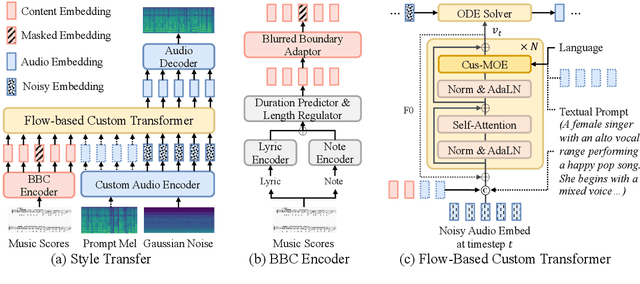
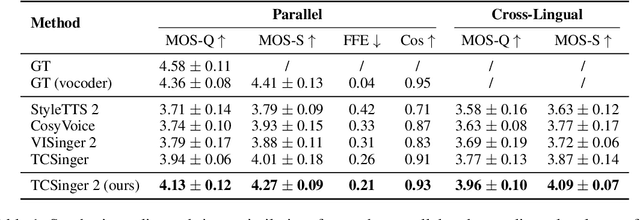

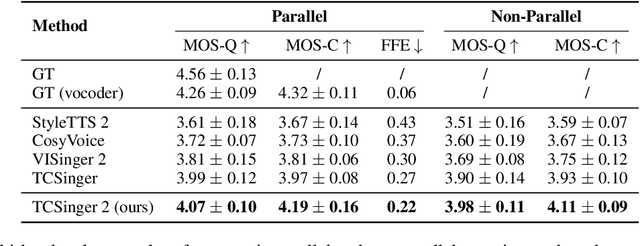
Abstract:Customizable multilingual zero-shot singing voice synthesis (SVS) has various potential applications in music composition and short video dubbing. However, existing SVS models overly depend on phoneme and note boundary annotations, limiting their robustness in zero-shot scenarios and producing poor transitions between phonemes and notes. Moreover, they also lack effective multi-level style control via diverse prompts. To overcome these challenges, we introduce TCSinger 2, a multi-task multilingual zero-shot SVS model with style transfer and style control based on various prompts. TCSinger 2 mainly includes three key modules: 1) Blurred Boundary Content (BBC) Encoder, predicts duration, extends content embedding, and applies masking to the boundaries to enable smooth transitions. 2) Custom Audio Encoder, uses contrastive learning to extract aligned representations from singing, speech, and textual prompts. 3) Flow-based Custom Transformer, leverages Cus-MOE, with F0 supervision, enhancing both the synthesis quality and style modeling of the generated singing voice. Experimental results show that TCSinger 2 outperforms baseline models in both subjective and objective metrics across multiple related tasks.
Missing Data Imputation by Reducing Mutual Information with Rectified Flows
May 16, 2025Abstract:This paper introduces a novel iterative method for missing data imputation that sequentially reduces the mutual information between data and their corresponding missing mask. Inspired by GAN-based approaches, which train generators to decrease the predictability of missingness patterns, our method explicitly targets the reduction of mutual information. Specifically, our algorithm iteratively minimizes the KL divergence between the joint distribution of the imputed data and missing mask, and the product of their marginals from the previous iteration. We show that the optimal imputation under this framework corresponds to solving an ODE, whose velocity field minimizes a rectified flow training objective. We further illustrate that some existing imputation techniques can be interpreted as approximate special cases of our mutual-information-reducing framework. Comprehensive experiments on synthetic and real-world datasets validate the efficacy of our proposed approach, demonstrating superior imputation performance.
WavReward: Spoken Dialogue Models With Generalist Reward Evaluators
May 14, 2025Abstract:End-to-end spoken dialogue models such as GPT-4o-audio have recently garnered significant attention in the speech domain. However, the evaluation of spoken dialogue models' conversational performance has largely been overlooked. This is primarily due to the intelligent chatbots convey a wealth of non-textual information which cannot be easily measured using text-based language models like ChatGPT. To address this gap, we propose WavReward, a reward feedback model based on audio language models that can evaluate both the IQ and EQ of spoken dialogue systems with speech input. Specifically, 1) based on audio language models, WavReward incorporates the deep reasoning process and the nonlinear reward mechanism for post-training. By utilizing multi-sample feedback via the reinforcement learning algorithm, we construct a specialized evaluator tailored to spoken dialogue models. 2) We introduce ChatReward-30K, a preference dataset used to train WavReward. ChatReward-30K includes both comprehension and generation aspects of spoken dialogue models. These scenarios span various tasks, such as text-based chats, nine acoustic attributes of instruction chats, and implicit chats. WavReward outperforms previous state-of-the-art evaluation models across multiple spoken dialogue scenarios, achieving a substantial improvement about Qwen2.5-Omni in objective accuracy from 55.1$\%$ to 91.5$\%$. In subjective A/B testing, WavReward also leads by a margin of 83$\%$. Comprehensive ablation studies confirm the necessity of each component of WavReward. All data and code will be publicly at https://github.com/jishengpeng/WavReward after the paper is accepted.
Versatile Framework for Song Generation with Prompt-based Control
Apr 29, 2025Abstract:Song generation focuses on producing controllable high-quality songs based on various prompts. However, existing methods struggle to generate vocals and accompaniments with prompt-based control and proper alignment. Additionally, they fall short in supporting various tasks. To address these challenges, we introduce VersBand, a multi-task song generation framework for synthesizing high-quality, aligned songs with prompt-based control. VersBand comprises these primary models: 1) VocalBand, a decoupled model, leverages the flow-matching method for generating singing styles, pitches, and mel-spectrograms, allowing fast, high-quality vocal generation with style control. 2) AccompBand, a flow-based transformer model, incorporates the Band-MOE, selecting suitable experts for enhanced quality, alignment, and control. This model allows for generating controllable, high-quality accompaniments aligned with vocals. 3) Two generation models, LyricBand for lyrics and MelodyBand for melodies, contribute to the comprehensive multi-task song generation system, allowing for extensive control based on multiple prompts. Experimental results demonstrate that VersBand performs better over baseline models across multiple song generation tasks using objective and subjective metrics. Audio samples are available at https://aaronz345.github.io/VersBandDemo.
Astrea: A MOE-based Visual Understanding Model with Progressive Alignment
Mar 12, 2025Abstract:Vision-Language Models (VLMs) based on Mixture-of-Experts (MoE) architectures have emerged as a pivotal paradigm in multimodal understanding, offering a powerful framework for integrating visual and linguistic information. However, the increasing complexity and diversity of tasks present significant challenges in coordinating load balancing across heterogeneous visual experts, where optimizing one specialist's performance often compromises others' capabilities. To address task heterogeneity and expert load imbalance, we propose Astrea, a novel multi-expert collaborative VLM architecture based on progressive pre-alignment. Astrea introduces three key innovations: 1) A heterogeneous expert coordination mechanism that integrates four specialized models (detection, segmentation, classification, captioning) into a comprehensive expert matrix covering essential visual comprehension elements; 2) A dynamic knowledge fusion strategy featuring progressive pre-alignment to harmonize experts within the VLM latent space through contrastive learning, complemented by probabilistically activated stochastic residual connections to preserve knowledge continuity; 3) An enhanced optimization framework utilizing momentum contrastive learning for long-range dependency modeling and adaptive weight allocators for real-time expert contribution calibration. Extensive evaluations across 12 benchmark tasks spanning VQA, image captioning, and cross-modal retrieval demonstrate Astrea's superiority over state-of-the-art models, achieving an average performance gain of +4.7\%. This study provides the first empirical demonstration that progressive pre-alignment strategies enable VLMs to overcome task heterogeneity limitations, establishing new methodological foundations for developing general-purpose multimodal agents.
Sparse Alignment Enhanced Latent Diffusion Transformer for Zero-Shot Speech Synthesis
Feb 26, 2025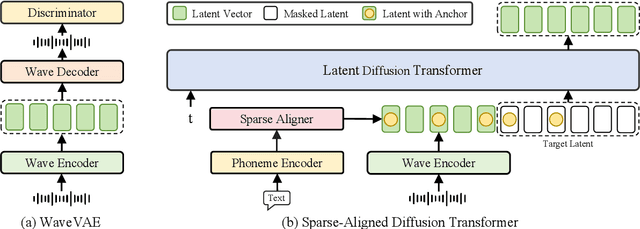

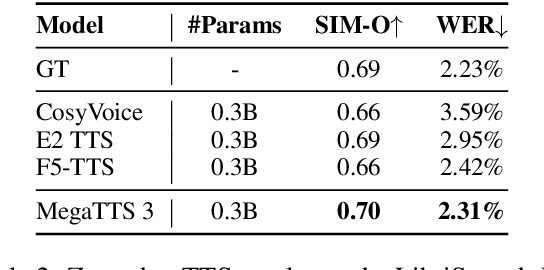
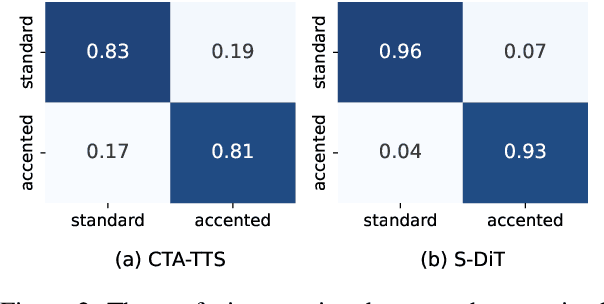
Abstract:While recent zero-shot text-to-speech (TTS) models have significantly improved speech quality and expressiveness, mainstream systems still suffer from issues related to speech-text alignment modeling: 1) models without explicit speech-text alignment modeling exhibit less robustness, especially for hard sentences in practical applications; 2) predefined alignment-based models suffer from naturalness constraints of forced alignments. This paper introduces \textit{S-DiT}, a TTS system featuring an innovative sparse alignment algorithm that guides the latent diffusion transformer (DiT). Specifically, we provide sparse alignment boundaries to S-DiT to reduce the difficulty of alignment learning without limiting the search space, thereby achieving high naturalness. Moreover, we employ a multi-condition classifier-free guidance strategy for accent intensity adjustment and adopt the piecewise rectified flow technique to accelerate the generation process. Experiments demonstrate that S-DiT achieves state-of-the-art zero-shot TTS speech quality and supports highly flexible control over accent intensity. Notably, our system can generate high-quality one-minute speech with only 8 sampling steps. Audio samples are available at https://sditdemo.github.io/sditdemo/.
Enhancing Expressive Voice Conversion with Discrete Pitch-Conditioned Flow Matching Model
Feb 08, 2025



Abstract:This paper introduces PFlow-VC, a conditional flow matching voice conversion model that leverages fine-grained discrete pitch tokens and target speaker prompt information for expressive voice conversion (VC). Previous VC works primarily focus on speaker conversion, with further exploration needed in enhancing expressiveness (such as prosody and emotion) for timbre conversion. Unlike previous methods, we adopt a simple and efficient approach to enhance the style expressiveness of voice conversion models. Specifically, we pretrain a self-supervised pitch VQVAE model to discretize speaker-irrelevant pitch information and leverage a masked pitch-conditioned flow matching model for Mel-spectrogram synthesis, which provides in-context pitch modeling capabilities for the speaker conversion model, effectively improving the voice style transfer capacity. Additionally, we improve timbre similarity by combining global timbre embeddings with time-varying timbre tokens. Experiments on unseen LibriTTS test-clean and emotional speech dataset ESD show the superiority of the PFlow-VC model in both timbre conversion and style transfer. Audio samples are available on the demo page https://speechai-demo.github.io/PFlow-VC/.
Speech Watermarking with Discrete Intermediate Representations
Dec 18, 2024Abstract:Speech watermarking techniques can proactively mitigate the potential harmful consequences of instant voice cloning techniques. These techniques involve the insertion of signals into speech that are imperceptible to humans but can be detected by algorithms. Previous approaches typically embed watermark messages into continuous space. However, intuitively, embedding watermark information into robust discrete latent space can significantly improve the robustness of watermarking systems. In this paper, we propose DiscreteWM, a novel speech watermarking framework that injects watermarks into the discrete intermediate representations of speech. Specifically, we map speech into discrete latent space with a vector-quantized autoencoder and inject watermarks by changing the modular arithmetic relation of discrete IDs. To ensure the imperceptibility of watermarks, we also propose a manipulator model to select the candidate tokens for watermark embedding. Experimental results demonstrate that our framework achieves state-of-the-art performance in robustness and imperceptibility, simultaneously. Moreover, our flexible frame-wise approach can serve as an efficient solution for both voice cloning detection and information hiding. Additionally, DiscreteWM can encode 1 to 150 bits of watermark information within a 1-second speech clip, indicating its encoding capacity. Audio samples are available at https://DiscreteWM.github.io/discrete_wm.
 Add to Chrome
Add to Chrome Add to Firefox
Add to Firefox Add to Edge
Add to Edge